Abstract
In this study, a numerical least squares (NLS) method for estimating the parameters of five-parameter Wakeby distribution was introduced. To asses the right tail estimate performances of the method, Monte Carlo simulated data and annual peak flows of 50 stations on Turkish rivers were used. Its results were compared to those by L-moments (LM) and curve fitting method of MATLAB. The biases from the LM for non-exceedence probability (F) of 0.999 mostly were less than those by the NLS. However, the values of relative root mean square error (rrmse) statistics from the NLS were better than those by the LM. In addition, the statistic of average deviation from the observed annual peak flows showed that NLS method exhibited mostly better results than those by LM for right tail predictions. Lastly, except the convergence problem of MATLAB, while both of the NLS and MATLAB produced the same determination coefficient (r 2) for the majority of data set, the NLS produced lower rrmse values than MATLAB.
Similar content being viewed by others
References
Ahmad MI, Sinclair CD, Spurr BD (1988) Assessment of flood frequency models using empirical distribution function statistics. Water Resour Res 24(8):1323–1328
Greenwood JA, Landwehr JM, Matalas NC, Wallis JR (1979) Probability weighted moments: definition and relation to parameters of several distributions expressable in inverse form. Water Resour Res 15(5):1049–1054
Griffiths GA (1989) A theoretically based Wakeby distribution for annual flood series. Hydrol Sci 34(3):231–248
Grubbs F, Beck G (1972) Extension of sample sizes and percentage points for significance tests of outlying observations. Technometrics 14(4):847–854
Haktanir T (1992) Comparison of various flood frequency distributions using annual flood peaks data of rivers in Anatolia. J Hydrol 136:1–31
Haktanir T, Horlacher HB (1993) Evaluation of various distributions for flood frequency analysis. Hydrol Sci 38(1):15–32
Haktanir T, Bozduman A (1995) A study on sensitivity of the probability-weighted moments method on the choice of the plotting position formula. J Hydrol 168:265–281
Hosking JRM (2000) Research report Fortran routines for use with the method of L-moments. Version 3.03, IBM Research Division, New York, p 33
Hosking JRM, Wallis JR (1997) Regional frequency analysis. Cambridge University Press, New York, p 224
Houghton JC (1978) Birth of a parent: the Wakeby distribution for modeling flood flows. Water Resour Res 14(6):1105–1109
Karamouz M, Abesi O, Moridi A, Ahmadi A (2009) Development of optimization schemes for floodplain management; a case study. Water Resour Manage 23(9):1743–1761
Kumar A, Chander S (1987) Statistical flood frequency analysis: an overview. In: Proceedings of the international symposium on flood frequency and risk analyses, hydrologic frequency modelling. D. Reidel Publishing Company, Dordrecht, pp 19–35
Landwehr JM, Matalas NC, Wallis JR (1979a) Probability weighted moments compared with some traditional techniques in estimating Gumbel parameters and quantiles. Water Resour Res 15(5):1055–1064
Landwehr JM, Matalas NC, Wallis JR (1979b) Estimation of parameters and quantiles of Wakeby distributions 1. Known lower bounds. Water Resour Res 15(6):1361–1372
Moharram SH, Gosain AK, Kapoor PN (1993) A comparative study for the estimators of the generalized Pareto distribution. J Hydrol 150:169–185
Öztekin T (2007) Wakeby distribution for representing annual extreme and partial duration rainfall series. Meteorol Appl 14(4):381–387
Press WH, Teukolsky SA, Vetterling WT, Flannery BP (1992) Numerical recipes in Fortran. Cambridge University Press, New York, p 963
Rao AR, Arora PS (1987) An empirical study of probability distributions of annual maximum floods. In: Proceedings of the international symposium on flood frequency and risk analyses, hydrologic frequency modelling. D. Reidel Publishing Company, Dordrecht, pp 449–465
Rao AR, Hamed KH (2000) Flood frequency analysis. CRC Press, New York, p 350
Sinclair CD, Spurr BD, Ahmad MI (1987) Modified Anderson-Darling test. Technical report, Department of Mathematics Science, St. Andrews University, St. Andrews, Fife, Scotland
The MathWorks Inc. (2005) MATLAB Release 7.1. Natick, MA
Vogel RM, McMahon TA, Chiew FHS (1993) Flood flow frequency model selection in Australia. J Hydrol 146:421–449
Zalina MD, Desa MNM, Nguyen VTV, Kassim AHM (2002) Selecting a probability distribution for extreme rainfall series in Malaysia. Water Sci Technol 45(2):63–68
Author information
Authors and Affiliations
Corresponding author
Rights and permissions
About this article
Cite this article
Öztekin, T. Estimation of the Parameters of Wakeby Distribution by a Numerical Least Squares Method and Applying it to the Annual Peak Flows of Turkish Rivers. Water Resour Manage 25, 1299–1313 (2011). https://doi.org/10.1007/s11269-010-9745-2
Received:
Accepted:
Published:
Issue Date:
DOI: https://doi.org/10.1007/s11269-010-9745-2
